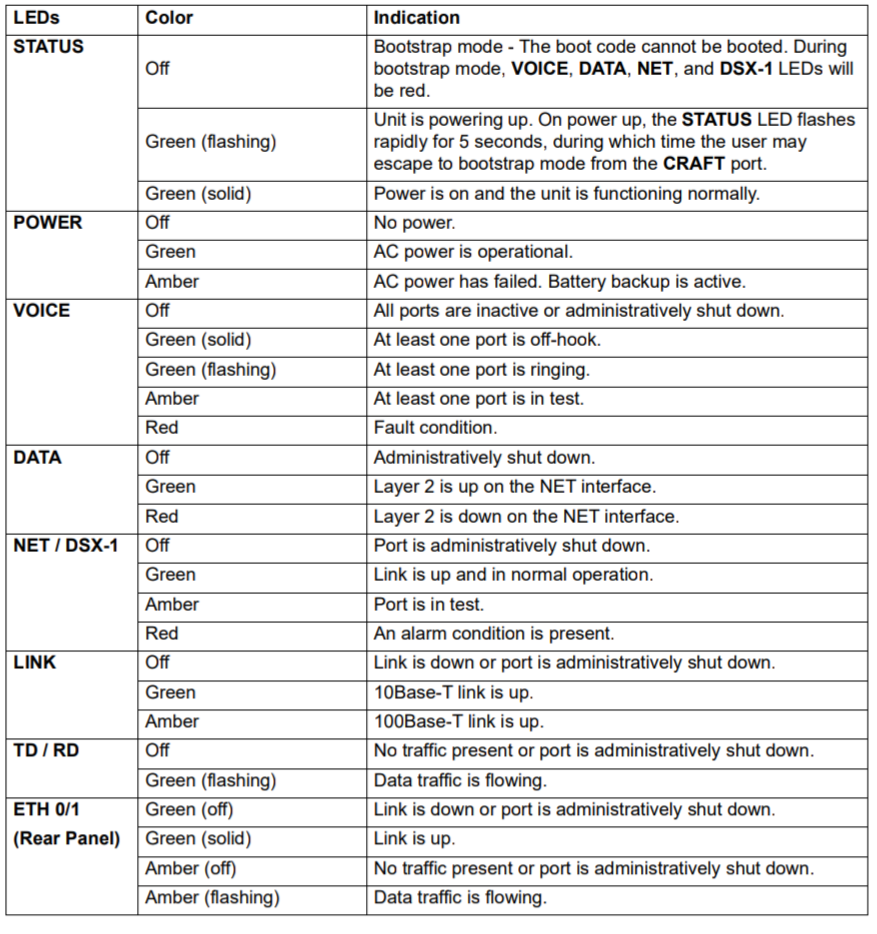The ADTRAN Total Access 900 Series is a versatile suite of business gateways designed to facilitate robust VoIP and data services in various enterprise environments. The devices in this series include several indicator lights (LEDs) on the front panel that provide real-time information about the system’s operational status. These LEDs are crucial for network administrators to quickly assess the health and performance of the unit. Below is a comprehensive overview of the LEDs found on the Total Access 900 Series.
1. STATUS LED
- Off: When the STATUS LED is off, the device is in bootstrap mode, indicating that the boot code cannot be loaded. This is typically a sign of a startup issue or a firmware problem.
- Green (flashing): During power-up, the STATUS LED will flash rapidly for approximately 5 seconds. This is a critical period where users can interrupt the startup sequence to enter bootstrap mode via the CRAFT port.
- Green (solid): A solid green light indicates that the device is powered on and functioning normally.
2. POWER LED
- Off: If the POWER LED is off, the device is not receiving power, which could be due to an unplugged power cord or a power supply issue.
- Green: A green light here means the device is receiving AC power and is operational.
- Amber: The amber light indicates that the AC power has failed, and the device is running on battery backup.
3. VOICE LED
- Off: When off, it means all voice ports are either inactive or have been administratively shut down.
- Green (solid): At least one voice port is off-hook, meaning there is an active voice call.
- Green (flashing): A flashing green light indicates that at least one port is ringing, which corresponds to an incoming call.
- Amber: An amber light signifies that at least one port is currently in test mode, often used for diagnostics.
- Red: A red light indicates a fault condition on one or more voice ports, suggesting an issue that needs to be addressed.
4. DATA LED
- Off: The data interface is administratively shut down when this light is off.
- Green: A green light indicates that Layer 2 (Data Link Layer) is up on the network interface, showing that the connection is active and functioning.
- Red: A red light here suggests that Layer 2 is down, indicating a problem with the network link.
5. NET/DSX-1 LED
- Off: The port is administratively shut down, meaning it has been disabled.
- Green: This light indicates that the link is up and running normally.
- Amber: An amber light means the port is in test mode, which is typically used for troubleshooting or diagnostics.
- Red: A red light signals an alarm condition, pointing to a critical issue with the network or DSX-1 interface that requires immediate attention.
6. LINK LED
- Off: This indicates that the link is down, or the port has been administratively shut down.
- Green: A green light signifies that a 10Base-T link is active, indicating a connection at 10 Mbps.
- Amber: An amber light indicates a 100Base-T link is active, showing a connection at 100 Mbps.
7. TD/RD LED
- Off: No traffic is being transmitted or received, or the port is administratively shut down.
- Green (flashing): A flashing green light indicates that data traffic is actively being transmitted or received on the port.
8. ETH 0/1 LED (Rear Panel)
- Green (off): Indicates the Ethernet link is down, or the port has been administratively shut down.
- Green (solid): A solid green light means the Ethernet link is active and connected.
- Amber (off): No data traffic is being transmitted or received.
- Amber (flashing): Data traffic is flowing through the Ethernet connection.
Conclusion
The LED indicators on the ADTRAN Total Access 900 Series devices are essential tools for network administrators. By understanding what each light signifies, you can quickly diagnose and resolve issues, ensuring the smooth operation of your network. Regular monitoring of these indicators can help you maintain optimal performance and reduce potential downtime in your network infrastructure. Whether it’s a power issue, a problem with voice or data services, or a network connection fault, these LEDs provide a first line of insight into the device’s operational state.

